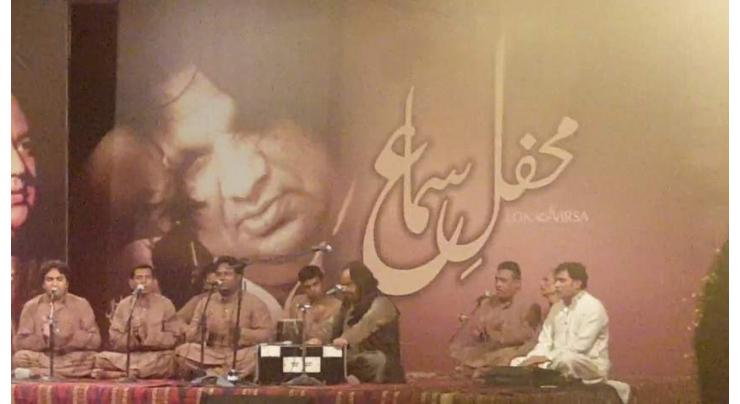
'Mehfil Samaa' A Traditional Qawwali Evening Held At Lok Virsa
Anees Ahmed (@Aneesah05582539) Published October 18, 2018 | 07:45 PM

National Institute of Folk and Traditional Heritage (Lok Virsa) Thursday organized "Mehfil-e-Samaa" an evening of traditional 'Qawwali' here at its Media Studies Center.
ISLAMABAD, (UrduPoint / Pakistan Point News - 18th Oct, 2018 ) :National Institute of Folk and Traditional Heritage (Lok Virsa) Thursday organized "Mehfil-e-Samaa" an evening of traditional 'Qawwali' here at its Media Studies Center.
Famous Qawwal Akhtar Sharif and Sabir Hussain enthralled the audience with their performance at "Mehfil-e-Samaa".
The Mehfil Samaa was attended by a large number of people from different walks of life.
They highly appreciated Lok Virsa for arranging special Qawwali evening to entertain the residents of twin cities of Islamabad and Rawalpindi.
Earlier, senior officials of Lok Virsa welcomed the audience and said that Qawwali, one of the most ancient and sacred forms of music, was being promoted through young artists.
They said that Qawwali evening was organized to entertain the people of twin cities.
The officials said that Qawwali is a musical form closely linked to Sufi traditions of islam and to the mystic practices developed by Sufi scholars to achieve closeness to God. Today, Qawwali is a group song performed by professional musicians in South Asia.
Amir Khusru (1253-1325), a famous Sufi saint ,poet and scholar, introduced, among others, two musical forms, the tarana and the qual, which are said to be the origin of Qawwali.
One of the objectives of Qawwali is to induce trance among the listeners, usually at the shrine of a Sufi saint. Qawwali is free in expression, but there are certain rules which may or may not be followed by performers.
A Qawwali starts with a short Alap (comparative utterances without words or rhythmic accompaniment), followed by Naghma, the dominant tune of the Qawwali performed on a harmonium with handclapping and drumbeats.
This is followed by a ruba'l (quartrain) which is usually sung without rythym. The main Qawwali is then launched , slowly gathering momentum and tempo while the performers carefully watch the audience. The dialogue between the the audience and the musicians is central to the performance of a Qawwali, the performers often repeating and dwelling on portions which strike a resonant chord with the listeners.
Recent Stories

ICC Womens T20 World Cup Qualifier, Match 2: Ireland Women open with Comfortable ..

Robinson, bowlers help New Zealand go 2-1 up against Pakistan

Shahzeb Chachar to hold khuli kachehri on April 26

Heatwave amid Israel's aggression in Gaza brings new misery, disease risk

Tourism must change, mayor says as Venice launches entry fee

Court adjourns Judicial Complex attack case till May 17

Nasreen Noori’s book ‘Popatan Jahra Khwab’ launched

Wafaqi Mohtasib inspection team visits Excise and taxation office

AJLAC announces 5th Conference titled ‘People’s Mandate: Safeguarding Civil ..

Pak-US officials engage to enhance trade, investment ties

IBCC to promote educational excellence, expand regional presence

Pakistani 'Blue Helmets' serving UN Peacekeeping Mission in DR Congo set to leav ..
More Stories From Showbiz
-

Nazish Jahangir denies viral screenshots, calls them fake
15 hours ago -

Aiman Khan granted UAE Golden Visa
2 days ago -

Dutch model Donny Roelvink embraces Islam
2 days ago -

Superstar Muhammad Ali remembered on 93rd birth anniversary
6 days ago -

Hania enjoys vacations in London
7 days ago -

Death anniversary of famous singer,actress Khursheed Bano observed
8 days ago
-

Bushra Ansari ties knot with Iqbal Hussain
10 days ago -

Rahat Fateh Ali Khan embarks on Umrah journey
20 days ago -

Famous singer Shaukat Ali death anniversary Shaukat Ali observed
23 days ago -

Animal Actor Shafina Shah loses Ms.Pakistan title
24 days ago -

Mehwish Hayat unveils trailer for upcoming film 'Dagha Baaz Dil’
24 days ago -

Welcome to the Beyonce rodeo: new country album drops to praise
26 days ago











